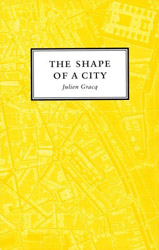In the 1920s Gracq lived for a time in Nantes. However, being a child at boarding school, only let outside the grounds on vacations and Sundays, his perceptions of the city are fragmented and idiosyncratic.
I lived in the heart of a city that loomed large in my imagination, but which I did not know very well. I was aware of certain landmarks, and familiar with some itineraries, but its substance, and even its smells, never lost their exotic flavor; a city where all the views led only to ill-defined, unexplored, faraway vistas, a loose framework easily absorbed into fiction.
The mysteries of a city we do not know well leave room for the imagination. And the pictures formed by our imagination outlast anything we may learn later, as reflected in the quotation from Baudelaire that provides the book’s title: “The shape of a city, as we all know, changes more quickly than the mortal heart.”
One result of only learning about the city through Sunday afternoon school promenades, is that he understands the structure of the city to be a series of lines radiating out from his school, like a starburst, with no interconnecting lines between them. His mental map does not at all correspond to the two-dimensional paper map of Nantes. As a dedicated map-reader, I’ve long been interested in the interplay between our mental maps and the various other sorts available.
Even if we think we know a city well, it can still surprise us.
There is always that element of surprise when, walking down streets one expects to be ugly . . . we suddenly see them transfigured by a ray of sunshine – like a moment of fleeting happiness. But such a surprise caused by the most insignificant event or impression can also happen elsewhere . . . it could be an unexpected declivity in the road which invites, tempts one to continue in that direction, a very slight turn of a road’s axis which both veils and partially reveals a perspective, a tree leaning over the sidewalk from above the crest of an ancient wall, a pleasing harmony in the rhythm of buildings alternating with free spaces which suddenly catches the eye. Instances when we are overcome by a feeling of how wonderful it would be to linger there, sure that life has regained its normal pace and recovered its guideposts, and that the universe has found a way to renew us and confirm its promises with just one brief, smiling look.
The power of memory and imagination that weave through this portrait of Nantes—a hybrid of memoir, reflections, and travel writing—shows Proust’s influence on Gracq. Here, though, the author is less concerned with the social mores and peoples’ foibles than with the place itself.
His descriptions of various parts of the city are beautiful and evocative, yet somehow wearying. They are mostly unconnected to bits of reverie or even memory beyond the fact of being there as a child. Thus, it’s a bit like seeing someone else’s vacation slides. If I had been to Nantes before, I would have been able to summon my own memories and thoughts, but I haven’t so after a while the descriptions ceased to engage me.
I’m far more interested in his thoughts, such as his meditation on the borderline areas between city and country.
This is perhaps why I am more sensitive than others to the existence of all kinds of boundaries along which the urban fabric tends to fray and unravel, areas neither within nor outside of city limits . . . once we start imagining there is just one step from boundary to frontier . . . Adrift on shreds of inhospitable land, slowly conquered by silence and mired in a sort of catalepsy, I could feel from afar the immense, haunting presence of the city, like that of a giant beast holed up in its lair whose respiration was the only sign of life. In almost every town where I have lived since then, whenever I went for a walk, my steps would automatically direct me toward some point of departure into the country.
With references to Rimbaud, Dickens, and Hugo among others, there is much of interest here even though some parts sag. Readers of his other work, such as The Opposing Shore, know to expect beautiful writing, a slower pace, and an intelligent and well-read companion who challenges us to dig deep into ourselves and our own experiences.
One reviewer said that this book is “a model for how to write about one’s home place[.] … It should be required reading for anyone setting out to describe their home place.”
How would you describe your home city?

